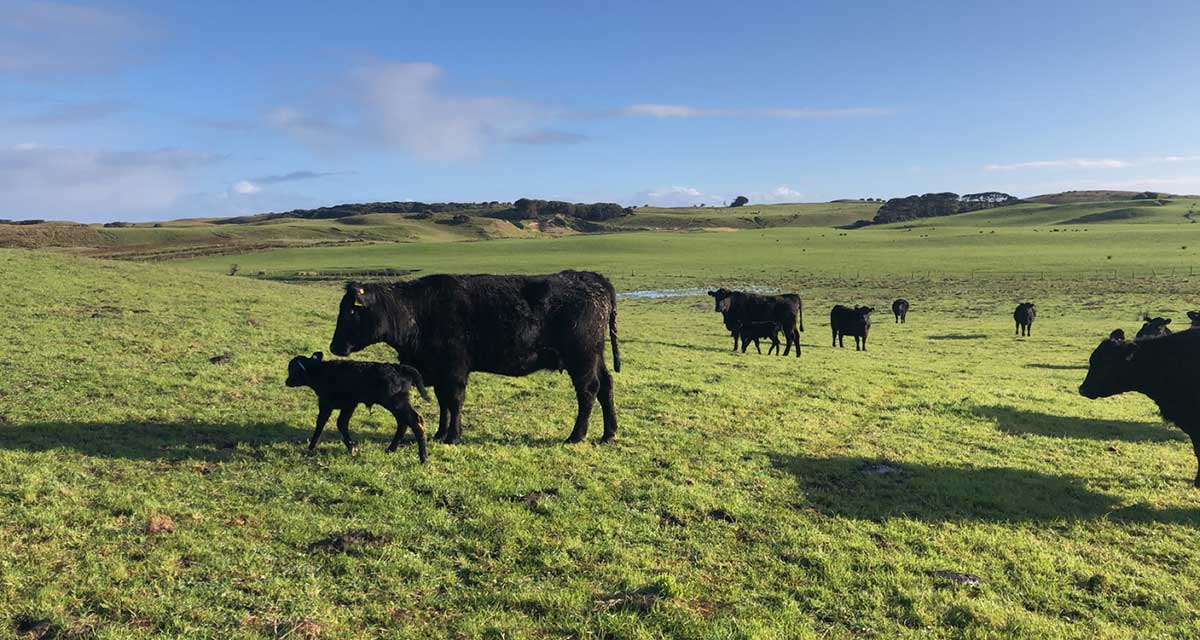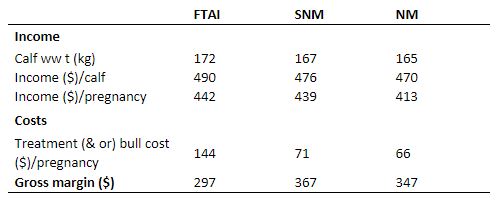An Economic Comparison of Fixed-time Artificial Insemination and Natural Mate in Commercial Angus Beef Heifers


Introduction
Artificial insemination programs are increasingly popular in commercial beef production systems. This is especially the case for heifers as it provides an opportunity to increase the number of early pregnancies, allowing greater recovery time before second joining, access to sires of greater genetic merit and the synchronisation improving labour efficiency at time of calving.
Methods
Angus beef heifers on King Island Tasmania were randomly allocated, based on weight and body condition score 42-days prior to joining, to one of three treatments: 1) fixed-time artificial insemination + oestrus detection protocol (FTAI; n=850); 2) single 250-μg dose of prostaglandin F2α, prior to natural mate (SNM; n=443); or 3) naturally mated (NM; n=403). Heifers from SNM and NM groups were exposed to bulls during the week of insemination, 12-days later the FTAI heifers were joined with the mob. These mobs remained for a further 6 weeks, a total ~8 week joining with the use of 58 bulls (bull to heifer ratio 1:29).
Results
Overall conception rates and conception cycle (1st, 2nd or 3rd cycle) did not differ between treatment groups (P=0.096). However, the FTAI heifer group was 11 days earlier (P<0.001) than the SNM and NM group based on fetal aging due to 56.1% of conceptions occurring on day one of mating.
Table 1. Conception rates per conception cycle; 1st cycle (first 21 days), 2nd (day 22 to 42) cycle and 3rd (day 43 to 63) for treatment groups.

Heifers that got in calf were heavier (P<0.01) at joining than those that did not. Those that were detected displaying oestrus had 30% greater conception rates to FTAI than those that were not detected in oestrus (69% vs 39%; P<0.001). Calving rate was high (97.2% of those PTIC) and did not differ between treatment groups (P=0.14). Eighty-seven percent of the FTAI treatment group calved by their due date compared to just 34% and 32% in the SNM and NM treatment groups.
Figure 1. Calving distribution; proportion of total birth by day from calving due date for treatment groups.

There was no difference in incidence of dystocia (manual assistance) (P=0.41), calf mortality (P=0.14), re-breeding conception rate or conception cycle (P=0.35) or weaning rate between treatment groups. However, calves from the FTAI heifer treatment group were on average 6kg heavier (P<0.001) at weaning compared to calves born to SNM and NM treatment groups, likely due to being 11 days older.
Table 2. Proportion of heifer slippage, manual assistance, calf mortality, weaning rate and re-breeding conception rates for treatment groups.

Economics
Treatment costs included semen, synchronisation hormones, technical and farm labour. Annual bull costs included purchase and developmental costs (homebred) and running costs (feed and treatments). Total cost per heifer pregnancy was 51% and 54% higher in the FTAI group ($144) than the SNM and NM heifer groups.
Table 3. Treatment and bull costs per heifer mated, overall conception rates and cost per heifer pregnancy for treatment groups.

The first approach to determine the value of a FTAI calf included a comparison between calves born to FTAI and those born to first cycle SNM and NM heifers only. Calves born to FTAI heifers had a greater value ($) due to higher weaning weights likely due to being older. Assuming weaning rate was no different across conception cycles, within a treatment group, income per heifer pregnancy was similar for FTAI and SNM which were slightly greater than NM (income per calf*WR). First cycle FTAI heifers did not incur backup bull costs thus treatment cost per heifer pregnancy was $141 ($79/0.56). Gross margin (income – costs) of a weaned calf was similar for FTAI and NM which were slightly lower than a weaned calf from a first cycle SNM heifer.
Table 4. Calf weaning weight, income per calf weaned, income per heifer pregnancy, treatment and bull costs per pregnancy and gross margin for fixed-time artificial insemination and 1st cycle synchronised natural mate and natural mate calves only.

To determine the value of FTAI as a reproductive strategy, relative to herd profit, included a comparison of all calves born to the FTAI treatment group and all calves born to the SNM and NM treatment groups. Calves born to the FTAI treatment group had a greater value due to higher weaning weights. Income per heifer pregnancy was greater in the FTAI and SNM treatment groups. In this approach FTAI heifers incurred backup bull costs, thus treatment and back up bull cost per heifer pregnancy was $144 ($134/0.93). Gross margin of calves weaned was greatest in the SNM treatment group and lowest in the FTAI treatment group.
Table 5. Calf weaning weight, income per calf weaned, income per heifer pregnancy, treatment and bull costs per pregnancy and gross margin for all calves weaned from treatment groups.

Despite the greater weaning weights of FTAI calves, treatment costs associated with FTAI diluted this benefit. The potential genetic merit of steer and heifer progeny born to FTAI sires was estimated by the difference in the Angus breeding index ($A) between the FTAI and natural mate sires. The FTAI sires had a potential genetic advantage of $39.50, only half of this value is inherited by the calf thus reduced the potential advantage to $19.75. However, it should be noted that only calves weaned to the 56.1% of heifers that conceived to FTAI would retain this potential advantage so the weighted average was $11.06/calf assuming this can be captured by the production system. If the genetic superiority of the sires were much greater the value proposition for FTAI would be stronger.
– Jena Alexopoulos
2024 Angus Foundation Research Grants Applications Open
Applications are now open for the 2024 Angus Foundation Research Grant. The Angus Foundation Research Grant is awarded, through eligible Australian universities, research providers and individual businesses, to undergraduate and post-graduate students to enable them to undertake research towards higher degrees in disciplines able to be applied to the Australian beef industries with the purpose to enhance and promote the value of Angus genetics and beef. LEARN MORE